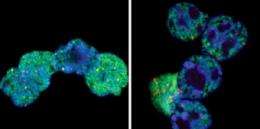Scientists track variant of gene-regulating protein in embryonic stem cells

(PhysOrg.com) -- The path to fully developed cells from embryonic stem cells requires that the right genes are turned on and off at the right times. New research from Rockefeller University shows that tiny variations between gene-regulating histone proteins play an important role in determining how and when genes are read. The finding shows that each region of the genome may be even more specialized than previously expected and may open a new avenue of investigation regarding the mysterious causes of the human genetic disease known as ATR-X syndrome.
“Our work shows that the regulation of histone variant localization -- the shape of the so-called epigenetic landscape at different regions of the genome — is more complex than previously thought,” says first author Aaron Goldberg, an M.D.-Ph.D. student in the Laboratory of Chromatin Biology and Epigenetics at Rockefeller.
Cells use a number of mechanisms to establish and maintain the activation or silencing of specific genes. Among these is the chemical modification of histones. But in addition, histone variants, which differ from other histone proteins by just a handful of amino acids, can be inserted at specific locations in the genome to provide a cell with another mechanism for fine-tuning gene regulation.
Previous work had identified a number of histone variants, including one known as H3.3. Studies in fruit flies established that histone H3.3 is prevalent in regions of the genome where active genes are found as well as at the ends of chromosomes, in telomeres.
To track histone H3.3 and distinguish it from other histone proteins, Goldberg and C. David Allis, Joy and Jack Fishman Professor and head of the Laboratory of Chromatin Biology and Epigenetics, collaborated with researchers at Sangamo Biosciences. Together, they designed and used a DNA-cutting enzyme called a zinc finger nuclease to chemically tag histone H3.3 and distinguish it from other histone proteins in mouse embryonic stem cells. They then used a technique called ChIP sequencing to produce the first genome-wide maps of H3.3 localization first in mammalian embryonic stem cells and then again after the cells had differentiated to become neurons. In collaboration with bioinformatics experts at the Albert Einstein College of Medicine, they found that the location of histone H3.3 throughout the genome changed with stem cell differentiation.
Most scientists in the field believed that a factor known as HIRA was responsible for controlling the localization of histone H3.3. To test this idea, Goldberg and Allis used ChIP sequencing to track H3.3 in normal embryonic stem cells and in genetically modified embryonic stem cells that lack HIRA, generated by colleagues in the United Kingdom. The researchers compared the genome-wide localization of H3.3 in the presence and absence of HIRA and, as expected, found that HIRA is required for H3.3 localization at genes. Without HIRA, H3.3 was mostly gone from genes.
But that wasn’t the whole story. Even without HIRA, H3.3 was still present in many other specific areas of the genome. The researchers went on to identify several additional proteins associated with H3.3.
Two of them, ATRX and Daxx, had never before been linked to H3.3. ATRX is particularly interesting, because mutations in the gene that codes for this protein in humans causes a genetic disease known as the α-thalassemia and X-linked mental retardation (ATR-X) syndrome.
“Instead of one universal factor for a particular histone variant, different factors are used to localize the same histone variant (H3.3) to different regions of the genome,” says Allis. “We now know that genes, transcription factor binding sites and telomeres all have their own dedicated series of proteins to properly localize histone H3.3.”
“Our work also demonstrates an important new function of the ATRX protein: the proper localization of histone H3.3 to telomeres,” says Goldberg. “This finding may provide a clue as to how mutations in the ATRX gene lead to the human genetic disease of α-thalassemia and X-linked mental retardation.”
More information: Distinct Factors Control Histone Variant H3.3 Localization at Specific Genomic Regions, Cell 140: 678-691 (March 5, 2010)
Provided by Rockefeller University
















